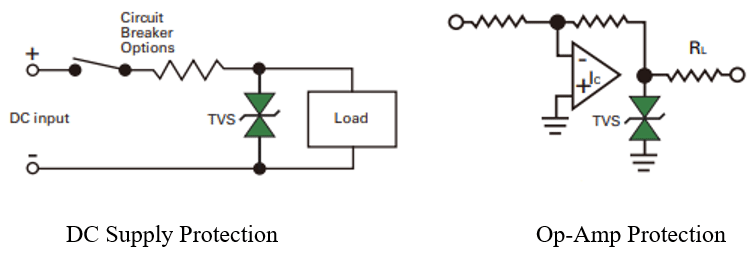Optimized at frequencies beyond traditional industry targets to support emerging applications
How to use TVS Diodes for Transient Voltage Suppression
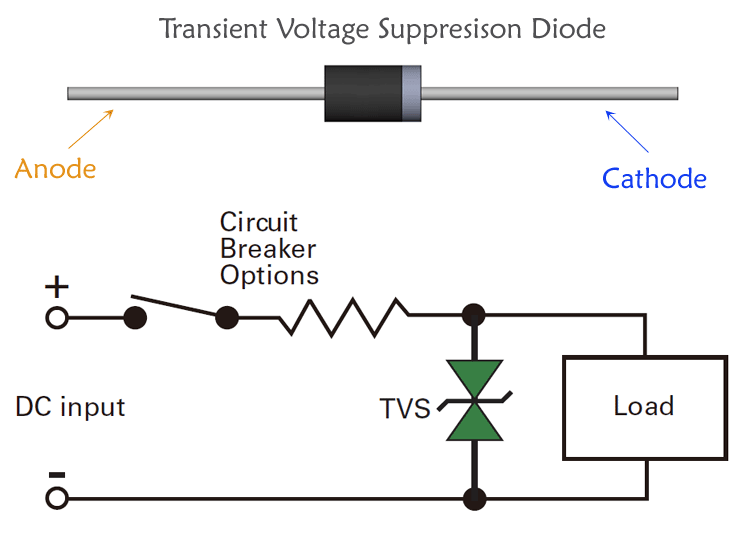
Diodes are the most fundamental semi-conductor device that is commonly used in many electronic designs like, Rectifiers, Converters, Inverters, Protections circuits, regulators, etc.. The three most commonly known type of diodes are Rectifier Diode (Common Diode), Zener Diode and Schottky Diode, we have already learned basic of diodes and their working. But there is yet another type of special diode known as the TVS Diode which plays a vital role in dealing with transient spikes in power electronics design circuits. In this article, we will look more into Transient voltage suppressors and why it is needed your circuit.
What is meant by transients?
Transients are short duration spikes in voltage or current that can damage a circuit in many ways. Some transients happen only once, and some can be repetitive. These transients range from a few millivolts to thousands of volts and can last from nanoseconds to hundreds of milliseconds.
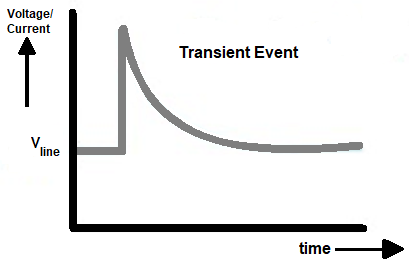
What causes Transients in a circuit?
Transients can be caused by internal or external connections in a circuit. For example, transients can be generated internally due to inductive load switching or faulty contacts in switches, and connectors. Externally it can generate due to lightning strikes or inductive switching.
Transient Voltage Suppressors (TVS)
Transient voltage suppressors or TVS are protection devices that are used to save your circuits from this sudden spike in voltage or current. The primary way to protect a circuit from overvoltage is to place these TVS devices in parallel with the circuit.
Types of Transient Voltage Suppressor
There are many types of TVS device that can be used for Transient Voltage Suppression namely Metal Oxide Varistor, TVS Diode, Zener Diode or a Bypass Capacitor.
Based on operation, Transient Voltage Suppressors can be divided into two classes, clamping, and crowbar. Clamping devices limit the voltage to a fixed level. In doing so, they absorb the excess energy of the overvoltage event. TVS diodes are an example of clamping devices.
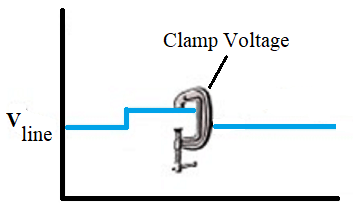
On the other hand, Crowbar devices once triggered essentially short out the protected line, redirecting the excess energy away from the protected circuit. As you can see in the below graph when a Trigger voltage (spike) is detected the crowbar device shorts the circuits thus the line voltage gets reduced, then after sometime when the crowbar device Delatchs the circuit the line voltage rises again to a stable state for normal operation of the circuit.
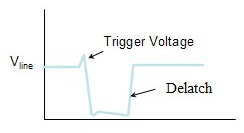
Transient Voltage Suppressor Diode –TVS Diode
Transient Voltage Suppressor Diode is a solid-state PN- Junction diode that is specially designed to nullify the sudden or momentary overvoltage effects on sensitive semiconductors and circuits. Transient Voltage Suppressor Diode is a clamping device, so whenever the induced voltage exceeds the avalanche breakdown voltage, it absorbs the excess energy of the overvoltage event, and then it automatically resets after overvoltage condition. While it is true that, standard diodes and Zener diodes can also be used for overvoltage/transient protection, but they are not as robust as transient voltage suppressor diodes because standard and Zener diodes are designed for rectification and voltage regulation.
Types of TVS Diode:
Transient Voltage Suppressor Diodes can be classified into two types. One is Unidirectional, and the other is Bidirectional.
A unidirectional Transient Voltage Suppressor Diode works as a rectifier in a circuit in the forward direction like any other avalanche diode, and this unidirectional diode is made to withstand very large peak currents. Symbol of a unidirectional TVS diode is shown in below image, and it is much like a Zener diode.

On the other hand, a bidirectional transient-voltage-suppression diode can be represented by two mutually opposing avalanche diodes connected in series with each other. These diodes are connected in parallel with the device or circuit to be protected. Unlike the symbol, these diodes are manufactured as a single component. Symbol of a Bidirectional TVS diode is shown in below image.
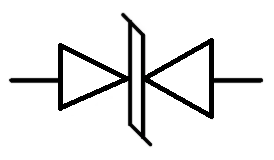
How to use TVS Diodes
TVS Diodes are connected in parallel with the device or circuit to be protected. The TVS device is specifically designed to breakdown at a specific voltage level and conducts large amounts of current without sustaining damage.
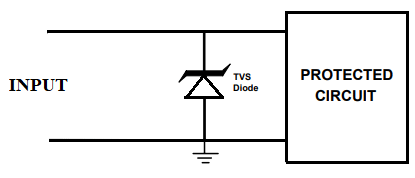
In the normal voltage conditions, TVS diode appears as an open circuit, but a small leakage current is present. When the normal voltage exceed to a certain level, the TVS diode junction avalanches and as the result overvoltage is diverted from the protected circuit and shunted through the TVS diode. The device automatically resets when the overvoltage goes away.
V-I Characteristics
V-I characteristics for both unidirectional and bidirectional TVS diode is shown in the graph below. This characteristic graph displays voltage and current relationships. A bi-directional diode has the same characteristic curve in the positive and the negative direction, so it does not matter which way they are connected into the circuit. A unidirectional diode has a higher turn-on voltage in the positive direction compared to the negative direction.
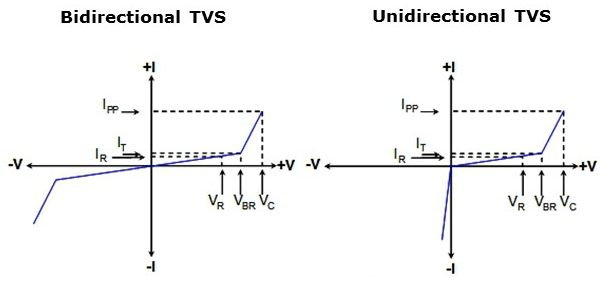
TVS Diode Parameters:
There are many types of TVS diode in the market, designed for a specific application. When you are selecting a TVS Diode you can look for the following terminologies in the datasheet to suit your design.
Reverse Stand-Off Voltage (VR): Reverse stand-off voltage is the maximum voltage that can be applied to the protector without actually activating the device. The device VR should be equal to, or higher than the peak operating voltage of the circuit being protected. This is to ensure that the protection device does not clip the normal circuit operating or signal voltage.
Breakdown Voltage (VBR): Breakdown voltage is the voltage at which the diode will begin to protect and conduct current. Generally, the VBR is specified at 1mA.
Clamping Voltage (VC): Clamping Voltage is the highest voltage that the protected circuit will be exposed to during the test waveform event. On most datasheets, the clamping voltage is given for a 1A or 2A waveform that has an 8µS rise time.
Peak Pulse Current (IPP): The peak pulse current is the maximum current the protection device can withstand.
Applications
TVS diode is normally used for Diversion/clamping in low-energy circuits and systems, and for ESD protection in circuits. Applications of Transient Voltage Suppressor Diode can be found in Data and Signal lines, Microprocessor and MOS memory, AC/DC power lines, and Telecommunication Equipments. Some example circuits are given below:
